| Oracle® Fusion Middleware Installation and Configuration Guide for Oracle Business Intelligence Applications 11g Release (11.1.1) Part Number E16814-03 |
|
|
PDF · Mobi · ePub |
| Oracle® Fusion Middleware Installation and Configuration Guide for Oracle Business Intelligence Applications 11g Release (11.1.1) Part Number E16814-03 |
|
|
PDF · Mobi · ePub |
This section contains tasks that relate to setting up Oracle BI Applications. For example, relating to Oracle BI Applications Configuration Manager, and Informatica PowerCenter. These tasks are used by the setup steps in Chapter 3, "Setting Up Oracle Business Intelligence Applications".
This section contains the following topics:
Section A.1, "How to Log Into Informatica PowerCenter Administration Console"
Section A.2, "How to Start Oracle BI Applications Configuration Manager"
Section A.3, "How to Optimize a Repository File (RPD) for Oracle BI Applications"
Section A.4, "How to Configure the DAC Server URL in a High Availability Environment"
Section A.5, "How to Verify Duty Roles required for Oracle BI Applications"
Section A.6, "About Warehouse Component Deployment Assistant (WCA)"
Informatica PowerCenter Administration Console is hosted from the machine that hosts the gateway node for the PowerCenter domain. For a single machine install of PowerCenter Services as described in this chapter, PowerCenter Administration Console is installed along with PowerCenter Services.
To log into PowerCenter Administration Console
In a supported Web browser, access the following URL:
http://<gateway host>:<domain port>
Where:
<gateway host> is the name of the machine on which the gateway node has been configured; for a single-machine installation of PowerCenter Services it is the name of the machine on which PowerCenter Services has been installed.
<domain port> is the port number for the gateway. The default port number is 6001.
In the login page, enter the domain user name and password that was specified when you created the domain during installation of PowerCenter Services (for example, Administrator\Administrator).
Display the Administration Console page.

You use Oracle BI Applications Configuration Manager to set up and manage several aspects of the Oracle BI Applications environment, and to manage and monitor Functional Configurations for Oracle BI Applications Offerings.
To start Oracle BI Applications Configuration Manager:
In a Web browser, enter the Oracle BI Applications Configuration Manager URL which your System Administrator provides you.
For example:
http://myexample.com:7001/biacm/
The Oracle BI Applications Configuration Manager Login dialog is displayed.
In the Login screen, log in with your user credentials.
Note: Your User Login must be associated to the appropriate Duty Role. For more information see Section 4.4, "About Users and Roles in Oracle BI Applications Configuration Manager". If you do not have access to Oracle BI Applications Configuration Manager or have incorrect access, then contact your Security Administrator.
The main Oracle BI Applications Configuration Manager page is displayed.
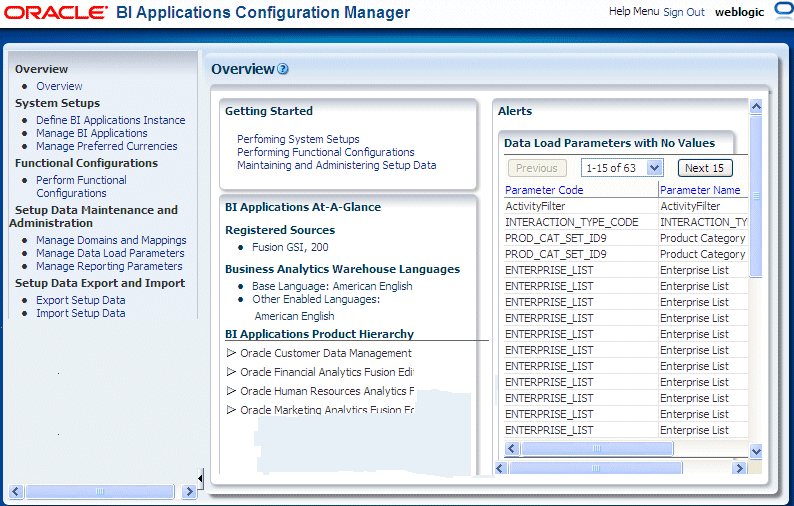
Notes
Use the Tasks bar on the left-hand side of the Welcome page to navigate the application.
The options that are displayed in the Tasks bar are dependent on the privileges of the user name that you log in with.
To display Help for the Overview page, click Help, then Configuration Manager Help. You can also display context-sensitive Help for any dialog by clicking the question mark icon displayed next to dialog or field names.
To log out of Oracle BI Applications Configuration Manager, select the Sign out link in the top right hand corner.
This section provides instructions for optimizing a BI repository (RPD file), and contains the following topics:
Section A.3.1, "Overview of Optimizing the Repository File (RPD) for Oracle BI Applications"
Section A.3.3, "Merging Repositories for Oracle BI Applications Projects"
Oracle BI Applications is installed with three RPD files:
an RPD file that contains all metadata for both Oracle Transactional Business Intelligence and Oracle BI Applications, referred to as the 'full RPD' (during Oracle BI Applications provisioning, this is the RPD file that is deployed to the BI Server).
an RPD file that contains only the CRM projects for both Oracle Transactional Business Intelligence and Oracle BI Applications.
an RPD file that contains only ERP projects, also for both Oracle Transactional Business Intelligence and Oracle BI Applications.
To makes BI Server startup faster and to make patching quicker, you can optimize the RPD by removing unused metadata so that it includes only the projects that you have purchased or that are relevant to your deployment.
The steps for optimizing the RPD for Oracle BI Applications depend on the status of your deployment, as follows:
Select the appropriate base RPD to start with. For example, for a CRM deployment, start with the RPD file for CRM.
If the RPD for Oracle Transactional Business Intelligence was previously optimized or customized for your deployment, extract the Oracle BI Applications projects from the full RPD and then merge that RPD with the RPD for Oracle Transactional Business Intelligence. See Section A.3.2, "Extracting Oracle BI Applications Projects" and Section A.3.3, "Merging Repositories for Oracle BI Applications Projects".
If the RPD for Oracle Transactional Business Intelligence was not previously optimized or customized for your deployment, extract the Oracle Transactional Business Intelligence and Oracle BI Applications projects for the products that you or your organization purchased. You do not need to perform a merge. See Section A.3.2, "Extracting Oracle BI Applications Projects" only.
Note:
To find out if Oracle Transactional Business Intelligence was previously deployed by your organization, contact your system administrator.
Follow the procedure in this topic to extract Oracle BI Applications projects.
To extract Oracle BI Applications projects from the RPD:
Open a command window on the computer where the Administration Tool for your deployment is installed.
Run bi-init.cmd (or bi-init.sh on UNIX systems) to launch a command prompt that is initialized to your Oracle instance. You can find this utility in:
ORACLE_INSTANCE/bifoundation/OracleBIApplication/coreapplication/setup
In the command prompt, change to the following directory:
MW_HOME\Oracle_BI1\bifoundation\server\bin
Run the following command:
ExtractProjects -B input_rpd -O output_rpd -I "project_name"
where:
input_rpd is the name and path of the RPD from which you want to extract the Oracle BI Applications project (for example, OracleBIApps.rpd)
output_rpd is the name and path of the RPD you want to create with the extracted Oracle BI Applications project (for example, OracleBIAppsBIAonly.rpd)
project_name is the name of the Oracle BI Applications project you want to extract
You will be prompted to enter the password for the RPD from which you are extracting the Oracle BI Applications project (input_rpd ).
To extract multiple projects, run the following command:
ExtractProjects -B input_rpd -O output_rpd -I "project_name1" -I "project_name2" -I "project_name3" (and so on)
For example, to extract specific projects you might run the following command:
C:\MWH\instances\instance1\bifoundation\OracleBIServerComponent\coreapplication_obis1\repository\OracleBIApps.rpd -O C:\MWH\instances\instance1bifoundation\OracleBIServerComponent\coreapplication_obis1\repository\OracleBIAppsBIAOnly.rpd -I "Customer Data Management Analytics Fusion Edition" -I "Financial Analytics Fusion Edition" -I "Human Resources Analytics Fusion Edition" -I "Marketing Analytics Fusion Edition" -I "Partner Analytics Fusion Edition" -I "Procurement and Spend Analytics Fusion Edition" -I "Product Information Management Analytics Fusion Edition" -I "Project Analytics Fusion Edition" -I "Sales Analytics Fusion Edition" -I "Supply Chain and Order Management Analytics Fusion Edition" Give password: my_rpd_password
Note: When you specify project names for the ExtractProjects command, use the following Oracle BI Applications project names:
Customer Data Management Analytics Fusion Edition
Financial Analytics Fusion Edition
Human Resources Analytics Fusion Edition
Marketing Analytics Fusion Edition
Partner Analytics Fusion Edition
Procurement and Spend Analytics Fusion Edition
Product Information Management Analytics Fusion Edition
Project Analytics Fusion Edition
Sales Analytics Fusion Edition
Supply Chain and Order Management Analytics Fusion Edition
Follow the procedure in this topic only if you previously optimized or customized the repository for Oracle Transactional Business Intelligence. If you did not previously optimize or customize the repository for Oracle Fusion Transactional Business Intelligence, you can ignore this topic and the following procedure.
To merge repositories for Oracle BI Applications projects:
In the Administration Tool, open in offline mode the Oracle BI repository that you created in Step 4 of Section A.3.2, "Extracting Oracle BI Applications Projects".
On the Administration Tool menu bar, click File and then Merge.
In the Select Original Repository dialog box, select the repository (for example, OracleBIApps.rpd).
Type the password for the original repository, and then click OK.
Click Select for the Modified Repository field. The Select Modified Repository dialog box opens.
In the Select Modified Repository dialog box, select the repository that contains the customizations you made to the previous RPD file (for example, OracleBIAppsOTBIonly.rpd).
Click Open, type the password for the previously customized RPD file, and then click OK.
In the Decision drop-down list, select the action you want to take regarding the repository change, or accept the default action.
To locate subsequent rows with empty Decision fields, click the Decision header cell. After all rows have a value in the Decision field, the Merge button becomes enabled.
Click Merge. A message appears after the merge concludes successfully.
On the File menu, click Save As, and save the current repository using a new name (for example, OracleBIAppsFinal.rpd).
The section describes how to deploy DAC Server in a high-availability environment.
In Oracle BI Applications 11g Release (11.1.1), the DAC Server is an enterprise application deployed into the Managed Server of the BI Domain. DAC Client is used to configure the URL of the DAC Server in the DAC Repository.
In a simple deployment (that is, Oracle BI Applications deployed into a single BI domain with the WebLogic Administration Server and Managed Server in the same domain home), the DAC Server URL is configured automatically. In a high-availability deployment, the DAC Server URL must be changed manually to the Oracle HTTP Server URL by following the steps below:
To configure the DAC Server URL:
Start DAC Client by navigating to the \dac directory and double-clicking the startclient.bat file. The Login dialog window opens.
In the Login dialog window, select the Configure.
In the Configuring dialog, select Create Connection, and then click Next.
Enter the appropriate connection information:
Name: Enter a unique name for the connection to the DAC repository.
Connection type: Choose Oracle (Thin).
Service Name: Enter the service name for the DAC Repository (prefix_DAC).
Database Host: Enter the name of the computer that hosts the DAC Repository database.
Database Port: Enter the port number for the database.
Click in the Authentication File field, and then do the following:
In the Authentication File dialog window, click Choose existing authentication file, and then click OK.
Navigate to the appropriate directory, select the cwallet.sso file that you copied from the DAC Server computer, and click OK.
If you installed DAC Client on a different machine to the Fusion Applications installed DAC Server, then you first need to copy cwallet.sso file across from server machine to dac client machine.
In the Configuring dialog window, click Test Connection to confirm the connection works.
Click Apply.
Click Finish.
In the drop-down list of the Login dialog window, select the Connection that you created.
Enter any values in the User Name and Password fields, as the DAC repository does not contain any user names or passwords. A user account will be created with the user name and password you enter. This user account is automatically assigned the Administrator role.
Select DAC as the Authentication Type.
Click Login.
In DAC Client, navigate to Tools menu, click DAC Server Management, and then click Repository Configuration.
In the Repository Configuration dialog window, enter the following information:
Mode: Web
URL: The URL for the DAC Server enterprise application deployed in WebLogic Server. For example, http://localhost:9704/DACServer.
Click Save.
Note:
For all subsequent logins to DAC Client, select the Connection and choose the FMW Authentication Type. Users will be authenticated against the LDAP system and must be granted the appropriate Oracle BI Applications duty role.
This section explains how to verify that Duty Roles for Oracle BI Applications are correctly mapped to Fusion Applications Enterprise Roles.
A list of required Enterprise Roles and Duty Roles for Oracle BI Applications is published on My Oracle Support (ID 1333454.1.) as a spreadsheet named 'Oracle Business Intelligence Applications Duty Role Assignments for Fusion Applications'.
The spreadsheet contains a sheet for each Oracle BI Applications Offering. For example, Oracle Financial Analytics, Oracle HR Analytics, and so on. Each sheet shows the following information:
The Fusion Applications Enterprise Job Roles in column A.
The associated Duty Roles in column B.
The Presentation Catalog areas mapped to the Duty Role in Column C.
The other columns show information, such as the modules to which the roles apply.
The example screenshot below shows a section from the Finance sheet, which contains Duty Roles for Oracle Financial Analytics.
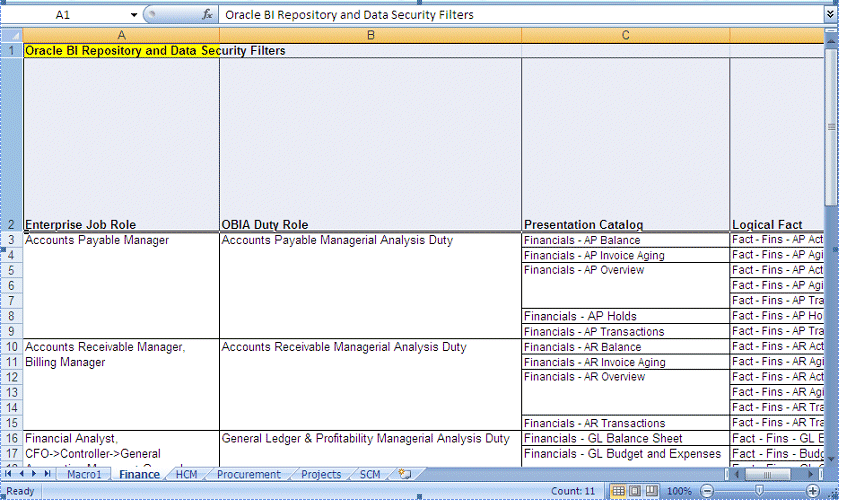
To verify that Duty Roles are mapped to appropriate Fusion Applications Enterprise Roles, do the following:
Download the spreadsheet named 'Oracle Business Intelligence Applications Duty Role Assignments for Fusion Applications', which is available on My Oracle Review as ID 1333454.1.
Use Oracle APM to verify that Duty Roles are mapped to the appropriate Enterprise Roles, as follows:
In Oracle APM, navigate to the 'obi' Application and use the Search options to locate Duty Roles prefixed with 'OBIA_'.
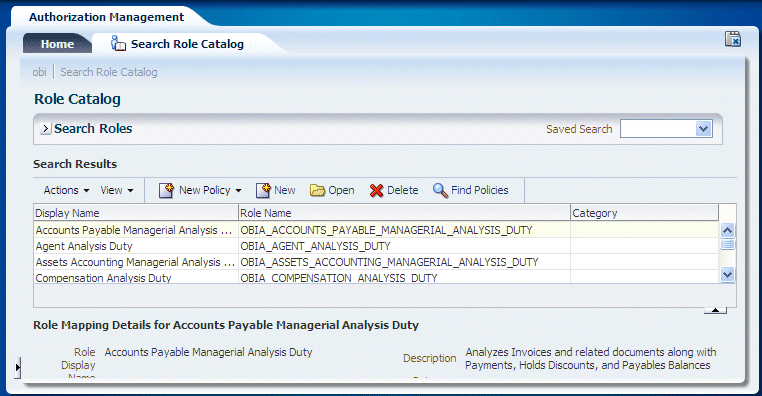
Select each Duty Role, then click Open to display the <Application> | Application Role dialog.
Display the External Role Mapping tab, and check that the role list contains the appropriate Enterprise Roles.
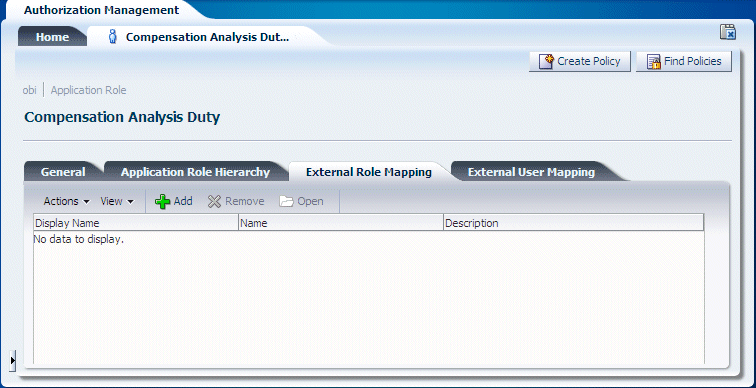
Use the spreadsheet 'Oracle Business Intelligence Applications Duty Role Assignments for Fusion Applications' to determine which Enterprise Roles should be displayed in the role list.
If you need to re-map Fusion Applications Enterprise Roles to Duty Roles, do the following:
In Oracle APM, navigate to the 'obi' Application and use the Search options to locate and select the Duty Role in the role list.
Click Open to display the <Application> | Application Role dialog.
Display the External Role Mapping tab.

Use the External Role Mapping tab to search for and select the Fusion Applications Enterprise Roles that must be mapped to that Duty Role.
Click Add to display the External Role Search dialog, which enables you to locate Enterprise Roles in the LDAP directory.
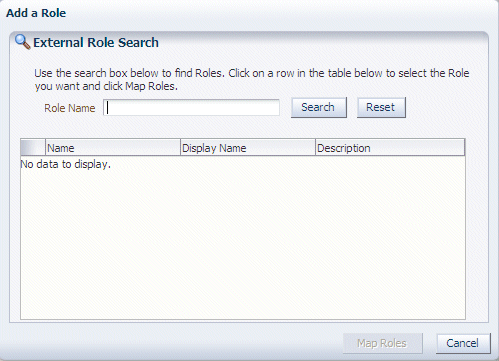
For example, the OBIA_WORKFORCE_DEPLOYMENT_ANALYSIS_DUTY Duty Role must be mapped to the PER_LINE_MANAGER_ABSTRACT Job Role and the PER_HUMAN_RESOURCES_VP_JOB Job Role.
Click Map Roles to map selected Enterprise Roles to the Duty Role, and return to the External Role Mapping tab.
For more information about using Oracle APM to manage Duty Roles and Enterprise Roles, refer to Oracle Fusion Middleware Oracle Authorization Policy Manager Administrator's Guide (Oracle Fusion Applications Edition).
Warehouse Component Deployment Assistant (WCA) is a configuration script that you use in UNIX environments to set up a new Oracle BI Applications Release 11.1.1.6 environment after Oracle BI Applications has been installed using the Oracle Fusion Applications installer. WCA is not supported on Windows platforms.
Note: If you have Informatica PowerCenter Services and DAC Server installed on the machine that hosts the BI Domain, then WCA configures all components. If you do not have Informatica PowerCenter Services and DAC Server installed on the machine that hosts the BI Domain, then WCA does not configure Informatica related components, and you must manually perform these configuration (for full details refer to the list below).
WCA is used as part of the setup process for Oracle BI Applications. For information about how to use WCA to configure an Oracle BI Applications environment, see Section 3.4.9, "Setup Step: Configure Oracle BI Applications components using Warehouse Component Deployment Assistant (WCA).", (which is Step 8 of Section 3.1.1, "High-level Tasks for Setting Up Oracle BI Applications.").
Warehouse Component Deployment Assistant does the following:
Configures DAC Properties, registers Informatica, and sets physical connections.
Registers Sources in Oracle BI Applications Configuration Manager.
Extends and configures the BI Domain.
Configures RPD Connection Pools.
Enables User Currencies.
Creates physical connections for Fusion Applications pillars, DW, and Oracle BI Applications Configuration Manager.
Creates an Integration Service for Informatica PowerCenter.
Note: This configuration step requires Informatica PowerCenter Services and DAC Server to be installed on the machine that hosts the BI Domain, and the CONFIGURE_INFA value set to 'y' in the wca_params.properties configuration file. If not, you must manually configure this component as described in Section 3.5.1, "Setup Step: Creating the Informatica Repository Service".
Restores the Informatica repository into the Repository Service.
Note: This configuration step requires Informatica PowerCenter Services and DAC Server to be installed on the machine that hosts the BI Domain, and the CONFIGURE_INFA value set to 'y' in the wca_params.properties configuration file. If not, you must manually configure this component as described in Section 3.5.2, "Setup Step: Restoring the Prebuilt Informatica Repository".
Creates a Repository Service for Informatica PowerCenter.
Note: This configuration step requires Informatica PowerCenter Services and DAC Server to be installed on the machine that hosts the BI Domain, and the CONFIGURE_INFA value set to 'y' in the wca_params.properties configuration file. If not, you must manually configure this component as described in Section 3.5.3, "Setup Step: Creating the Informatica Integration Service".
Copy source files and sets custom properties.
Note: This configuration step requires Informatica PowerCenter Services and DAC Server to be installed on the machine that hosts the BI Domain, and the CONFIGURE_INFA value set to 'y' in the wca_params.properties configuration file. If not, you must manually configure this component as described in Section 3.5.4, "Setup Step: Copying Source Files to the Informatica PowerCenter Services machine".
Creates an Administrator user for the Informatica repository.
Note: This configuration step requires Informatica PowerCenter Services and DAC Server to be installed on the machine that hosts the BI Domain, and the CONFIGURE_INFA value set to 'y' in the wca_params.properties configuration file. If not, you must manually configure this component as described in Section 3.5.7, "Setup Step: Creating the Repository Administrator User in the Native Security Domain".
Sets Informatica PowerCenter properties, and creates relational connections in Informatica.
Note: This configuration step requires Informatica PowerCenter Services and DAC Server to be installed on the machine that hosts the BI Domain, and the CONFIGURE_INFA value set to 'y' in the wca_params.properties configuration file. If not, you must manually configure this component as described in Section 3.5.11, and Section 3.5.12, "Setup Step: Setting the SiebelUnicodeDB Property in Informatica Integration Services".